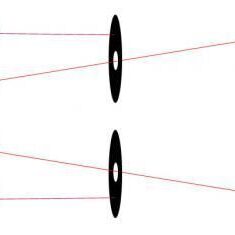What is presbyopia?
Presbyopia is not a disease. It is a natural process where ageing influences the mechanism of eye accommodation. That’s why it affects more than 2 billion people globally.
The human eye normally has very good distant, intermediate and near vision. For example, intermediate distance can be considered the distance from our desk chair to the computer screen or from the table chair to our dish. When we read a book or a text on a mobile screen we are using our near vision.
Nature endowed human beings with the ability to “auto adjust” the power of the lens within the eye, so as to accommodate for intermediate or near vision, similarly to the automated zoom function of a photographic camera lens.
Symptoms
Presbyopia develops normally between the ages of 35 and 50, when the crystalline lens loses its flexibility. The individual has difficulty in focusing on objects at near distance, making reading difficult. Presbyopia increases progressively and the need for glasses becomes imperative from the age of 45 onwards.
Treatment
There is no treatment for presbyopia, although, sometimes, even ophthalmologists use this term. There are, however, some methods that we could use to improve the near vision.

Monovision
The first, oldest and probably most popular technique is monovision, correcting the non-dominant eye to have good near vision.
Dominant is the eye we use to aim with (shooting a gun in a fun park or aiming through a lens of an old camera). Some people may use the term “ my good eye”. The other, the non-dominant eye is the one we try to induce some myopia to. This is achieved by the use of special glasses or a contact lens or by the insertion of a special lens during cataract surgery for an older patient. Monovision gives the opportunity to the non-dominant eye to focus better on near distance objects and to the dominant eye to focus better on distant objects.
However, the disadvantage of monovision is the loss of the stereo optical vision (the perception of depth or the three dimension image that require both eyes to work equally). In monovision, we sacrifice a percentage of the stereo optical vision, which is perceived differently by every individual. Some people can tolerate it very well and other people do not like it at all.
As we have been teaching for over 15 years in the instructional courses of the American Academy and the European Society of Refractive Surgeons, the best solution is to first try this method by using contact lenses in our office. This means that for people who are interested, we use the relevant contact lenses that can simulate the phenomenon of monovision in order for them to assess if they tolerate it and how much it benefits them. Glasses cannot simulate it as realistically as contact lenses. If the patient decides to proceed with monovision correction, we can then use the normal laser that we use to correct myopia, hyperopia and astigmatism.
PresbyLASIK
Inlays
A third option would be inlays (special synthetic implants with multifocal properties placed within the cornea).
However, this technique also has its drawbacks, as quite a few implants have had to be removed since they negatively affected vision quality during nighttime driving (halos and double images). It certainly is neither a radical solution nor a cure to presbyopia: only a way to deal partially with its symptoms.
Clear Lens Extraction (IOL Implantation)
PiXL (Photorefractive Crosslinking)
Our scientific team has recently developed photorefractive crosslinking: a non-invasive technique, where the non-dominant eye is induced with slight myopia, creating a minor monovision effect. Photorefractive Crosslinking neither involves laser treatment, nor corneal tissue removal: Riboflavin (B2 Vitamin) drops combined with UVA light are utilised. This technique was first applied in Athens, Greece, Summer 2013 and has already been published and presented in global Opthalmology Congresses from our pioneer scientific team.
Needless to say, this technique also requires a sacrifice in stereo vision. The patient undergoes a contact lens trial before deciding whether to proceed.
Our Opinion
Nowadays, there are many options when it comes to dealing with Presbyopia, some better than others. There is no one-size-fits-all regime for Presbyopia. It depends on the individual’s needs based on their daily routine. The experienced surgeon will assess for instance how many hours they spend driving at night, if they’ve had prior experiences with multifocal glasses or contacts etc).
My personal experience with laser vision correction, spanning over 25 years of practicing as a surgeon – ophthalmologist, was highly enriched when we performed these types of treatments to airplane pilots. Their visual performance directly affects their career. In most cases, hyperopia becomes apparent between the ages of 45 and 55, leading them to seek some type of laser vision correction. Some opted for monovision, whereas others chose to have good distant vision while using spectacles for near distance, based on their individual needs.
Our protocol always includes contact lens trials with every possible scenario, helping the individual decide on the option that better suits their daily routine. We always underline that these are techniques to improve near vision rather than to “treat” presbyopia.


